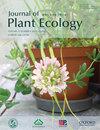中国北方半干旱草原生态系统光合特性的季节和年际变化
IF 3.9
2区 环境科学与生态学
Q2 ECOLOGY
引用次数: 4
摘要
生态系统表观量子产率(α)、最大总CO2同化率(Pmax)和白天生态系统呼吸速率(Rd)是反映生态系统生理功能的重要光合参数,是估算生态系统碳平衡的重要参数。气候驱动因素可能通过改变植被的响应而直接或间接地影响光合参数。然而,环境和生理控制的相对贡献和调控途径尚不清楚,特别是在半干旱草原。利用2006 - 2017年12 a的涡旋协方差观测资料,对内蒙古典型半干旱草地光合参数的季节和年际变化进行了分析。采用回归分析和结构方程模型(SEM)分离环境和生理效应的贡献。光合参数呈单峰型季节变化,年际变化显著。气温(Ta)和土壤含水量(SWC)的变化驱动光合参数的季节变化,而SWC的年际变化占主导地位。此外,与Ta对α和Rd的主导作用相比,SWC比Ta更能解释Pmax的差异。SEM结果表明,环境因子通过调节林冠层气孔导度所反映的生理反应,直接或间接地影响了光合参数。叶面积指数(LAI)直接影响α、Pmax和Rd,主导Pmax的变化。另一方面,SWC通过LAI和冠层表面导度(gc)间接影响光合参数。我们的发现强调了生理调节对光合参数和碳同化能力的重要性,特别是在水资源有限的草地生态系统中。本文章由计算机程序翻译,如有差异,请以英文原文为准。
Seasonal and interannual variations of ecosystem photosynthetic characteristics in a semi-arid grassland of Northern China
The ecosystem apparent quantum yield (α), maximum rate of gross CO2 assimilation (Pmax), and daytime ecosystem respiration rate (Rd) reflecting the physiological functioning of ecosystem, are vital photosynthetic parameters for the estimation of ecosystem carbon budget. Climatic drivers may affect photosynthetic parameters both directly and indirectly by altering the response of vegetation. However, the relative contribution and regulation pathway of environmental and physiological controls remain unclear, especially in semi-arid grasslands. We analyzed seasonal and interannual variations of photosynthetic parameters derived from eddy-covariance observation in a typical semi-arid grassland in Inner Mongolia, northern China, over 12 years from 2006 to 2017. Regression analyses and a structural equation model (SEM) were adopted to separate the contributions of environmental and physiological effects. The photosynthetic parameters showed unimodal seasonal patterns and significantly interannual variations. Variations of air temperature (Ta) and soil water content (SWC) drove the seasonal patterns of photosynthetic parameters, while SWC predominated their interannual variations. Moreover, contrasting with the predominant role of Ta on α and Rd, SWC explained more variances of Pmax than Ta. Results of SEM elucidated that environmental factors impacted photosynthetic parameters both directly and indirectly through regulating physiological responses reflected by stomatal conductance at the canopy level. Moreover, leaf area index (LAI) directly affected α, Pmax and Rd and dominated the variation of Pmax. On the other hand, SWC influenced photosynthetic parameters indirectly through LAI and canopy surface conductance (gc). Our finding highlights the importance of physiological regulation on the photosynthetic parameters and carbon assimilation capacity, especially in water-limited grassland ecosystems.
求助全文
通过发布文献求助,成功后即可免费获取论文全文。
去求助
来源期刊

Journal of Plant Ecology
生物-植物科学
CiteScore
4.60
自引率
18.50%
发文量
134
审稿时长
3 months
期刊介绍:
Journal of Plant Ecology (JPE) serves as an important medium for ecologists to present research findings and discuss challenging issues in the broad field of plants and their interactions with biotic and abiotic environment. The JPE will cover all aspects of plant ecology, including plant ecophysiology, population ecology, community ecology, ecosystem ecology and landscape ecology as well as conservation ecology, evolutionary ecology, and theoretical ecology.
 求助内容:
求助内容: 应助结果提醒方式:
应助结果提醒方式:


